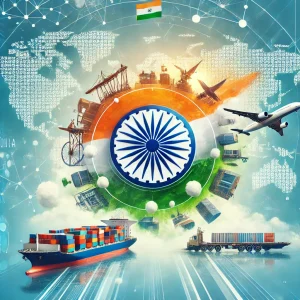In 2024, Indian exports face a dynamic landscape shaped by shifting geopolitical tensions, evolving trade policies, and intensifying global competition. While the potential for growth in Indian exports is significant, exporters must navigate a range of challenges, from regulatory barriers to stiff competition from countries like China. This article explores the current state of Indian exports, the geopolitical factors at play, the barriers hindering exporters, and how India can position itself in the global market.
Geopolitical Landscape and Its Impact on Indian Exports
The global geopolitical landscape in 2024 is marked by volatility and uncertainty. The ongoing trade wars between major economies, rising protectionism, and the fallout from the COVID-19 pandemic continue to influence trade dynamics. For Indian exporters, these factors have created both opportunities and obstacles.
Here’s a free blog side to help you sourcing products at wholesale rate
Shifting Alliances and Trade Agreements
One of the most significant geopolitical developments is the realignment of global alliances. India’s relationship with the United States has strengthened, leading to potential opportunities for increased exports in sectors like pharmaceuticals, textiles, and IT services. On the other hand, tensions with China, India’s largest trading partner, have led to a push for diversifying trade partners and reducing dependency on Chinese imports.
The Russia-Ukraine Conflict: A Double-Edged Sword
The ongoing conflict between Russia and Ukraine has had far-reaching consequences for global trade. For India, this has meant disruptions in key export markets, particularly in Europe. However, the conflict has also opened up new opportunities in the energy sector, where India can potentially increase its exports of refined petroleum products to Europe.
Export Barriers for Indian Exporters
Despite the potential for growth, Indian exporters face several barriers that hinder their ability to compete effectively on the global stage. These barriers range from regulatory hurdles to logistical challenges and a lack of infrastructure.
Regulatory Hurdles and Compliance Issues
Indian exporters often grapple with complex regulatory requirements both domestically and internationally. The lack of harmonization in international trade regulations creates a significant burden, particularly for small and medium-sized enterprises (SMEs). Compliance with standards set by developed markets, such as the European Union and the United States, can be costly and time-consuming.
Additionally, India’s own regulatory framework is often seen as cumbersome, with multiple layers of bureaucracy that slow down the export process. The recent introduction of stricter environmental regulations, while essential for sustainable development, has added another layer of complexity for exporters, particularly in industries like textiles and chemicals.
Infrastructural Challenges
India’s infrastructure, while improving, still lags behind that of its global competitors. Inadequate port facilities, poor road connectivity, and unreliable power supply are significant challenges for exporters. These issues lead to delays and increased costs, making Indian products less competitive in the global market.
The government’s focus on infrastructure development, including initiatives like the Sagarmala project, aims to address these issues. However, the impact of these initiatives will take time to materialize, and in the interim, exporters must find ways to mitigate these challenges.
Logistical Issues and Supply Chain Disruptions
The global supply chain disruptions caused by the COVID-19 pandemic continue to affect Indian exports. While some of these issues have eased, challenges such as container shortages, fluctuating freight rates, and shipping delays persist. Indian exporters must navigate these logistical hurdles to ensure timely delivery of their products to international markets.
Competition from China and Other Global Players
China continues to be India’s most formidable competitor in the global export market. With its well-established manufacturing base, advanced technology, and efficient supply chains, China dominates several key industries, including electronics, textiles, and machinery. Indian exporters must compete with Chinese counterparts who often benefit from lower production costs and economies of scale.
The Rise of Southeast Asian Economies
Beyond China, Indian exporters face growing competition from Southeast Asian countries like Vietnam, Thailand, and Indonesia. These countries have become attractive alternatives for global buyers due to their competitive pricing, favorable trade agreements, and strategic locations. India’s ability to compete with these economies will depend on its ability to innovate, reduce costs, and enhance the quality of its products.
The Role of Free Trade Agreements (FTAs)
India has been actively pursuing Free Trade Agreements (FTAs) with various countries to boost its export potential. However, the effectiveness of these agreements depends on how well Indian exporters can leverage them. While FTAs offer reduced tariffs and better market access, they also require Indian products to meet stringent quality and compliance standards. Indian exporters must invest in improving product quality and adhering to international standards to fully benefit from these agreements.
The Role of Technology and Innovation
In an increasingly competitive global market, technology and innovation are critical for Indian exporters. The adoption of advanced manufacturing techniques, digitalization, and automation can help reduce costs, improve efficiency, and enhance product quality.
Embracing Industry 4.0
Industry 4.0, characterized by the integration of digital technologies into manufacturing processes, offers significant opportunities for Indian exporters. By adopting technologies like the Internet of Things (IoT), artificial intelligence (AI), and robotics, Indian manufacturers can enhance productivity, reduce waste, and improve supply chain management. This, in turn, can make Indian exports more competitive in the global market.
The Digital Export Landscape
The rise of e-commerce platforms and digital marketing has opened up new avenues for Indian exporters. By leveraging digital tools, exporters can reach a broader audience, reduce dependence on traditional distribution channels, and improve customer engagement. The government’s push for digital trade, through initiatives like the Digital India program, is expected to further boost Indian exports in the coming years.
Strategic Recommendations for Indian Exporters
To navigate the complexities of the global market in 2024, Indian exporters must adopt a strategic approach that addresses the challenges outlined above.
Diversifying Export Markets
One of the most effective strategies for mitigating geopolitical risks is diversifying export markets. By expanding their presence in emerging markets in Africa, Latin America, and Southeast Asia, Indian exporters can reduce their dependence on traditional markets like the United States and Europe. This diversification will also help spread risk and create new opportunities for growth.
Enhancing Product Quality and Compliance
To compete effectively in the global market, Indian exporters must focus on enhancing product quality and ensuring compliance with international standards. This will require investment in research and development, as well as a commitment to sustainable and ethical manufacturing practices.
Strengthening Infrastructure and Logistics
Improving infrastructure and logistics is crucial for reducing export costs and ensuring timely delivery of goods. While the government is investing in infrastructure development, exporters must also explore alternative solutions, such as collaborating with logistics providers, to overcome existing challenges.
Conclusion
In 2024, Indian exports are poised at a crossroads, with significant opportunities for growth alongside considerable challenges. The geopolitical landscape, competition from China and other global players, regulatory hurdles, and infrastructural issues all play a crucial role in shaping the future of Indian exports. By adopting a strategic approach that embraces technology, diversifies markets, and enhances product quality, Indian exporters can navigate these complexities and succeed in the global market.
Call to Action
As Indian exporters look to the future, it’s essential to stay informed about global trade trends and adapt to the evolving market conditions. Subscribe to our blog for the latest insights and expert advice on overseas trade, market trends, and strategic export solutions.
See Also:
List Of Overseas Import Trade Leads 2024

